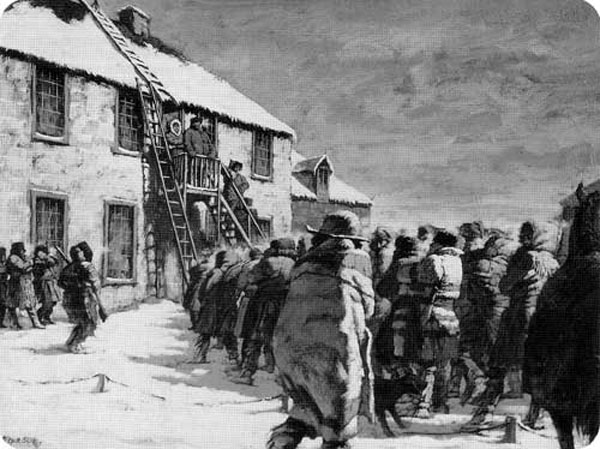
Upper Fort Garry and the Red River Resistance: The Birth of Manitoba and Winnipeg and the Growth of Canada
By the 1840s the development of an independent economy among both the French and English Metis challenged HBC hegemony in the region. From its administrative headquarters at Upper Fort Garry, the company attempted to assert authority over a growing class of free traders, entrepreneurs who operated outside the HBC charter. The Sayer trial of 1849 highlighted the disputes over free trade and by mid-century the HBC’s monopolistic control had largely disappeared. In its place came the commerce of a new Metis entrepreneurial elite that developed extensive and independent trading contacts, and introduced real energy and growth in the settlement.
Canadian annexationists began to arrive in the settlement in the late 1850s and the company’s rule in the Northwest came increasingly under attack by Canada and Great Britain. As negotiations to transfer the region from HBC to Canadian authority commenced in the 1860s, the Metis inhabitants of the West became alarmed that their land and cultural rights, including the protection of language, faith, and education, would not be respected. Neither the British nor Canadian governments made genuine efforts to allay these fears, treating the Northwest as if devoid of inhabitants. Local concerns with the transfer of Rupert’s Land to Canada in 1869 were increased by Canadian attempts to resurvey the settlement. Then, an armed party of Metis gathered at a location near St. Norbert that has come to be known as La Barrière, to prevent the entry of newly-appointed Canadian governor William McDougall into the territory. The Metis actions of defiance over the sale of Rupert’s Land led Ottawa to refuse to take over the territory on December 1st of that year as had been previously arranged.
Louis Riel emerged as the leader of Metis resistance in Red River. Many local residents refused to take sides, remaining suspicious of both Canadian and Metis rule. While annexationists under the leadership of John Christian Shultz actively opposed Riel, HBC officials at Upper Fort Garry remained at least outwardly neutral.
In the vacuum that was civil government in Red River, Riel seized Upper Fort Garry in early November of 1869, consolidating his authority and military dominance in the settlement. In December of 1869 he declared a provisional government, drafted a list of rights, and on a frigid January day in 1870 met at Upper Fort Garry with Donald Smith, HBC official and special commissioner from the Canadian government, in front of a crowd of 1000 local settlers. From this meeting came a second convention and list of rights, an agreement to send representatives to Ottawa to bargain with the federal government, as well as HBC approval of the legitimacy of the Provisional Government.
Riel was now firmly in control. The execution of a troublesome Orangeman from Ontario, Thomas Scott, turned the Canadian Government against the Metis leader. Later, their refusal to grant amnesty forced Riel to flee when Wolseley and his troops arrived in the settlement. Meanwhile in March of 1870, the Legislative Assembly of the Provisional Government organized the territory of Assiniboia and Ottawa approved the evolving list of rights demanded by the Metis, including provincial status, responsible government, denominational schools, and the guarantee of existing land titles. And while the new province of Manitoba was given royal assent on 12 May, 1870 it was only a fraction of the lands of the Northwest which came under Canadian control. Even within Manitoba public lands were controlled by the federal government and 1.4 million acres were reserved for the children of mixed-blood families. Later governments would badly mismanage the land grants and many were deprived of their lands in the province.
So while the Provisional Government had won concessions, and a new province created, the Metis were soon engulfed in the “Reign of Terror,” as incoming troops and Canadian “colonizers” used violence to show their displeasure with Metis status in the new province. The ensuing history of Winnipeg in the early 1870s demonstrates how these early Canadian immigrants and their armed force effectively ended Metis ascendency in the old settlement and drove many from Manitoba to seek new lands to the west.
During the turbulent events of 1869-70 Upper Fort Garry played a pivotal role. It was the military stronghold that gave Riel the power and legitimacy both within the settlement and with Ottawa, the site of the sittings of the Legislative Assembly of Assiniboia, the place where the settlement gathered to hear the negotiations between Riel and Smith, and just outside its southwest gate, the site of the ill-fated execution of Scott.
For decades the upper fort had been at the centre of historic events. A settlement developed on these few acres at the junction of the Red and Assiniboine Rivers because it was a meeting place and a market place. The fort was built to provide protection for the trade, the settlement, and the community’s legal institutions. The first new province of Canada was created here when citizens of diverse backgrounds, faiths, and outlooks overcame their differences and planned a common future. A city grew in the fort’s shadow. Decisive moments in the history of North America took place on this ground and within this fort, a site about the size of several city blocks and containing, at its busiest moment, a dozen buildings and a few hundred residents.





